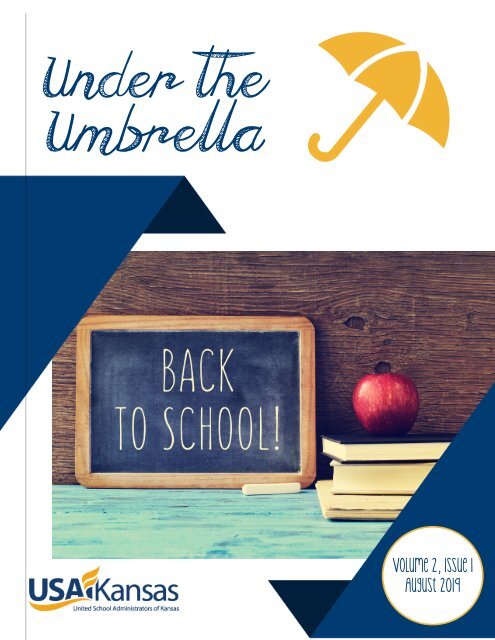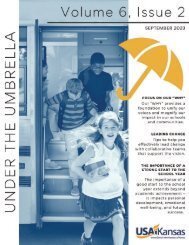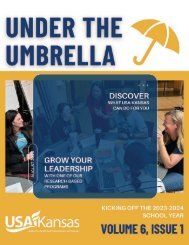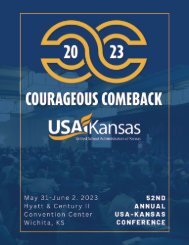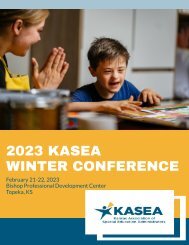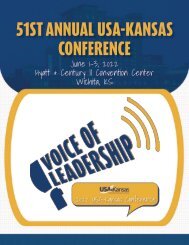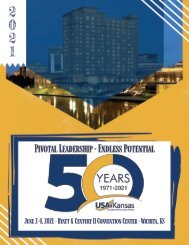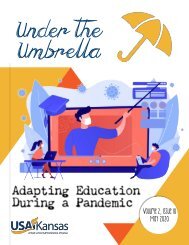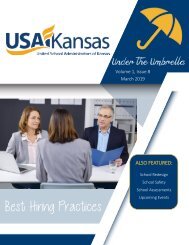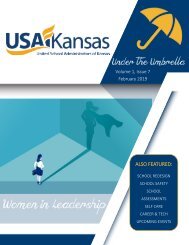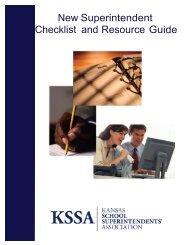Under the Umbrella, Volume 2, Issue 1
You also want an ePaper? Increase the reach of your titles
YUMPU automatically turns print PDFs into web optimized ePapers that Google loves.
<strong>Under</strong> <strong>the</strong><br />
<strong>Umbrella</strong><br />
<strong>Volume</strong> 2, <strong>Issue</strong> 1<br />
August 2019
CONTENTS <strong>Volume</strong> 2, <strong>Issue</strong> 1<br />
2 Don’t Do It Alone, G.A. Buie<br />
BACK TO SCHOOL<br />
3 New School Year, Ryan Jilka<br />
4 New School Year, New Opportunities, Jerry Henn<br />
7 Preparing for <strong>the</strong> New School Year, Stacey Green<br />
8-9 KAESP and KASSP Kick Off <strong>the</strong> Year With<br />
Beginning Principals Workshops, Duane<br />
Dorshorst<br />
10-11 Starting Off On <strong>the</strong> Right Foot: Engaging and<br />
Effective Back-to-School Messaging, Joe Sample<br />
12 The Great Debate: Renovate or Build New?,<br />
Scott Pashia<br />
SCHOOL REDESIGN<br />
14 Resistors and Detractors—The Saboteurs of<br />
Delta, Dr. John Vandewalle<br />
SCHOOL SAFETY<br />
16 Thinking Training For <strong>the</strong> New School Year, Doug<br />
Parisi<br />
17 Social Media a Double-Edged Sword For<br />
Students With Disabilities, Study Finds, Benjamin<br />
Herald<br />
17 Heart, Head and Hand For School Safety, Art J.<br />
McCoy<br />
UPCOMING EVENTS<br />
18-19 Rethinking Leadership and Why, G.A. Buie<br />
NETWORK & STAY CONECTED<br />
@USAKansas<br />
Facebook.com/USAKansas<br />
2019-2020 USA-Kansas<br />
Board of Directors<br />
Ryan Jilka—President, KAMSA<br />
Christie Meyer—President-Elect, KASCD<br />
Sean Cochran—Past President, KASEA<br />
Eric Sacco—Director, KAESP<br />
Mike Berblinger—Director, KSSA<br />
Cory Gibson—Director, KSSA<br />
Eric Hansen—Director, KASBO<br />
Justin Henry—Director, KSSA<br />
Jake Potter—Director, KanSPRA<br />
Volora Hanzlicek—Director, KASCD<br />
Mike Argabright—Director, KSSA<br />
P.J. Reilly—Director, KLCTE<br />
Donna Schmidt—Director, KASSP<br />
Glen Suppes—Director, KSSA<br />
Patrick Schroeder—Director, KAESP<br />
TBD—Director, KASSP<br />
TBD—Director, KASSP<br />
TBD—Director, KASPA<br />
TBD—Director, KASEA<br />
G.A. Buie—Executive Director<br />
Jerry Henn—Assistant Executive Director
DON’T DO IT ALONE<br />
G.A. Buie, Executive Director, USA-Kansas<br />
August, it’s back to school for<br />
<strong>the</strong> kids, summer break is<br />
coming to a close, and for<br />
everyone it’s time for a fresh<br />
start and a new beginning. It’s<br />
an opportunity for school<br />
leaders to continue <strong>the</strong><br />
success of your best programs or a chance to<br />
ga<strong>the</strong>r <strong>the</strong> data and start moving in a new<br />
direction. It doesn’t matter <strong>the</strong> situation.<br />
Everyone gets to reset <strong>the</strong> clock and create a new<br />
beginning.<br />
important that schedules, calendars, decorations,<br />
and a host of o<strong>the</strong>r task are completed before <strong>the</strong><br />
excitement of <strong>the</strong> first day.<br />
Communities love to celebrate <strong>the</strong> excitement of a<br />
new school year. Stores kick it off with “back to<br />
school” sales, parents celebrate by taking one last<br />
long weekend get-away, and kids begin to<br />
compare schedules and complain about <strong>the</strong><br />
unknown. Yet, behind <strong>the</strong> scenes, administrators<br />
have <strong>the</strong>ir own excitement. The stress of<br />
understanding how critical <strong>the</strong> start to <strong>the</strong> school<br />
year is to <strong>the</strong> overall success of <strong>the</strong> entire school<br />
year.<br />
Those administrators who have experienced <strong>the</strong><br />
excitement/stress of a new school year<br />
understand <strong>the</strong> difficulty and time-consuming task<br />
of planning a new year. Making sure teachers and<br />
staff members are hired and orientation covers<br />
everything plus a few “what if’s”, pushing <strong>the</strong><br />
timeline on summer construction or improvement<br />
projects assuring <strong>the</strong>y are wrapped up or at least<br />
not interfering with <strong>the</strong> learning. Finally, it’s time<br />
to welcome students, parents, and <strong>the</strong> public to a<br />
new school year, but before that first day it’s<br />
2<br />
As you manage <strong>the</strong> long hours leading to <strong>the</strong><br />
exciting first day, as you cope with <strong>the</strong> next<br />
challenging task and work through <strong>the</strong> sea of<br />
changes, yes, it is important <strong>the</strong> students, staff,<br />
and public only see your best smile. This time of<br />
year can be a stressful, hectic, and lonely time.<br />
You feel every question falls to you and each<br />
answer might lead to <strong>the</strong> next big challenge. It’s<br />
important to remember you don’t have to lead<br />
alone. True leadership is shared. When you feel<br />
backed into <strong>the</strong> corner without an answer, please<br />
don’t start digging a hole. Reach out and talk with<br />
a peer, share your story, ask for advice, lean on a<br />
friend, but don’t carry <strong>the</strong> burden of leadership by<br />
yourself. We are blessed in Kansas to have a<br />
wonderful network of administrators and friends.<br />
Don’t feel like you’re on an island. Take care of<br />
yourself and make sure you can enjoy <strong>the</strong><br />
experience and excitement of a new school year<br />
with your students.
BACK TO SCHOOL<br />
NEW SCHOOL YEAR<br />
Ryan Jilka, Principal of Discovery Intermediate School USD 265, USA-Kansas Board President<br />
Happy New School Year! I hope<br />
<strong>the</strong> summer has treated you all<br />
very well, and you’ve had <strong>the</strong><br />
opportunity to recharge your<br />
batteries for <strong>the</strong> best year ever!<br />
Getting back into <strong>the</strong> building (if<br />
you ever truly left) can be filled<br />
with a whirlwind of mixed emotions. It’s exciting to<br />
know that you get to incorporate new and improved<br />
strategies for <strong>the</strong> betterment of all students, but with<br />
that comes <strong>the</strong> angst of how to best implement <strong>the</strong>se<br />
ideas for maximum effect. There is often a sadness<br />
for those that have moved on, but we also feel <strong>the</strong><br />
exhilaration of knowing we have a whole new group<br />
that we get to help and love.<br />
Positivity: /ˌpäzəˈtivədē/<br />
noun - <strong>the</strong> practice of being or tendency to be<br />
positive or optimistic in attitude.<br />
"Pupils draw power from <strong>the</strong> positivity of <strong>the</strong>ir<br />
teachers."<br />
If you Google<br />
“positivity,” this is <strong>the</strong><br />
first thing you’ll see,<br />
and I don’t think it’s a<br />
mere coincidence that<br />
<strong>the</strong> example given<br />
speaks of <strong>the</strong> power educators possess. My<br />
challenge to everyone this year is to not only strive to<br />
maintain positivity, but to also spread it like wildfire.<br />
As Hall of Famer, Wade Boggs said, “A positive<br />
attitude causes a chain reaction of positive thoughts,<br />
events and outcomes. It is a catalyst and it sparks<br />
extraordinary results.” Please take <strong>the</strong> time to offer<br />
kind remarks to those that it’s a challenge, celebrate<br />
things often overlooked, and wear a smile every day.<br />
Those things are contagious and good for <strong>the</strong> soul.<br />
I look forward to a<br />
year of getting to<br />
know my fellow USA-<br />
Kansas colleagues, as<br />
well as sharing our<br />
thoughts and ideas<br />
that continue to make public education in Kansas<br />
world class. We are coming off of an extremely<br />
successful 2019 Conference, and I hope we carry that<br />
momentum into this school year. I wish you all a year<br />
of great success for all your new ventures and<br />
challenges!<br />
Download <strong>the</strong><br />
USA-Kansas App!<br />
Search for USAK in<br />
<strong>the</strong> app store or<br />
use this QR code<br />
for fast access!<br />
3
NEW SCHOOL YEAR, NEW OPPORTUNITIES<br />
Jerry Henn, Assistant Executive Director, USA-Kansas<br />
At <strong>the</strong> beginning of a new school<br />
year I always heard, “Where did<br />
<strong>the</strong> summer go?” It does seem<br />
<strong>the</strong> summer time moves much<br />
quicker than during <strong>the</strong> school<br />
year, but I would like to believe<br />
and argue <strong>the</strong> school year moves<br />
just as quick as <strong>the</strong> summer and maybe quicker.<br />
The beginning of <strong>the</strong><br />
school year is an<br />
opportunity to change<br />
lives, educate all levels<br />
of people, and give you<br />
as an administrator <strong>the</strong><br />
opportunity to help students become successful. The<br />
o<strong>the</strong>r part of your job is to ‘teach’ teachers and have<br />
<strong>the</strong>m understand what <strong>the</strong>ir goal is; to teach<br />
students. This all begins much before <strong>the</strong> first day of<br />
school.<br />
Lastly, do not forget your own families. They must<br />
come first. When I was in <strong>the</strong> building<br />
administration role, my wife was <strong>the</strong> best. During a<br />
night activity, she would bring supper to <strong>the</strong> school<br />
and my children and wife would sit down and have<br />
a picknick in my office. We all made sacrifices, but<br />
our family was toge<strong>the</strong>r, and we still had family at<br />
suppertime. This is just one idea. I also made time<br />
on <strong>the</strong> weekends for <strong>the</strong>m. I never thought twice<br />
about <strong>the</strong> time I spent at home with my family.<br />
When it was time to work, that is what happened.<br />
Relationship building has to be a focus of each school<br />
year. You will have new staff members and new<br />
students that all will benefit from a relationship with<br />
you as <strong>the</strong> administrator. Make those bonds and be<br />
a positive role model for all.<br />
It would be nice if you could start each day as <strong>the</strong><br />
beginning of <strong>the</strong> school year. The enthusiasm that is<br />
evident at <strong>the</strong> beginning of each school year is<br />
tremendous. Just think how nice that would be for a<br />
positive environment within <strong>the</strong> school year. Talk<br />
about <strong>the</strong> year going fast, I bet you would be looking<br />
at each day totally different. Great opportunities are<br />
made at <strong>the</strong> beginning of a year, month, day, hour.<br />
4<br />
So, have a great start to <strong>the</strong> school year, each day!<br />
Always focus on those relationships, with new staff<br />
and students as well as all o<strong>the</strong>r staff and students.<br />
Make this <strong>the</strong> best school year ever. Remain<br />
positive in all aspects of <strong>the</strong> job. You will have<br />
challenging days, but use <strong>the</strong>se as learning<br />
experiences. As usual, you can always call <strong>the</strong> USA<br />
office with your ideas and questions.<br />
Tel: 785.232.6566<br />
Fax: 785.232.9776<br />
usaoffice@usakansas.org
PREPARING FOR THE NEW SCHOOL YEAR<br />
Stacey Green, Principal of Stockton Grade School USD 271<br />
When <strong>the</strong> livestock trailers roll<br />
into town holding precious four<br />
legged 4-H cargo, <strong>the</strong> ferris<br />
wheel lights up in <strong>the</strong> night sky,<br />
and motorcycles roar late into<br />
<strong>the</strong> evening circling <strong>the</strong> dirt<br />
track, you know it’s time for<br />
<strong>the</strong> Rooks County Free Fair.<br />
This week in August is sacred time on <strong>the</strong> calendar, and<br />
rightly so with its rich history of community. For<br />
students and staff at USD 271 Stockton, it is also a<br />
reminder that <strong>the</strong> start of <strong>the</strong> new school year will<br />
begin <strong>the</strong> following week.<br />
As we prepare for <strong>the</strong> beginning<br />
of a new school year and I develop<br />
a plan for my summer and <strong>the</strong> first<br />
months, I find that my roles switch<br />
often. With <strong>the</strong> arrival of spring, I<br />
find myself with one foot in <strong>the</strong><br />
current school year and one foot<br />
in <strong>the</strong> next. We are closely<br />
monitoring class size fluctuations,<br />
reviewing data, exploring staff movement, developing<br />
purchasing plans, and addressing professional<br />
development needs for <strong>the</strong> upcoming school year. It is<br />
in this planning I am most comfortable and passionate. I<br />
am an instructional lead learner. It is my why. I want<br />
what is best for our students and I know that starts with<br />
collective teacher efficacy.<br />
I am a small school leader. I don’t know any o<strong>the</strong>r role<br />
as I’ve been a part of Stockton schools for 29 years, and<br />
with six of those years in administration. I can’t firsthand<br />
say that my role is any different than an<br />
administrator in a large school because I’ve not lived<br />
that role, but through my connections with large school<br />
administrators, I’ve come to <strong>the</strong> conclusion that it is not<br />
all that different. I can best share my view as a small<br />
school administrator by sharing a sampling of <strong>the</strong><br />
conversations I have had over <strong>the</strong> last past two weeks<br />
as we head into <strong>the</strong> final stretch before school starts.<br />
We are busy interviewing, hiring, and meeting with our<br />
newest teachers; presenting with<br />
teacher leaders at <strong>the</strong> Impact<br />
Institute to share about our Kansans<br />
Can school redesign; consulting with<br />
our district janitors on <strong>the</strong> amount<br />
of wax still needed to finish up our<br />
summer maintenance; contacting<br />
our retired janitor to mow <strong>the</strong> lawns<br />
while we are short staffed with illness; assisting our<br />
board clerk with <strong>the</strong> Local Consolidated Plan annual<br />
report; welcoming our new superintendent to <strong>the</strong><br />
district; developing a plan with our athletic directors<br />
and high school administrator to set up CPR and AED<br />
training for staff; and much more. In all of this <strong>the</strong>re is a<br />
“we” as we work toge<strong>the</strong>r to accomplish greatness. The<br />
key is that <strong>the</strong> “we” in a small district is fewer in<br />
numbers. If <strong>the</strong>re was a flowchart for decision making it<br />
would be very short. We don’t work in isolation, but<br />
decision making steps can come quickly.<br />
Community is one of my core values and I prepare and<br />
lead with community in mind. In a small district it takes<br />
each one of us preparing for <strong>the</strong> year ahead. Our best<br />
prepared plans are only that - a plan. I know that each<br />
day something will change and we will problem solve<br />
and pivot to get <strong>the</strong> job done. I know way more about<br />
floor wax, LED lighting, roof repair, toilet paper<br />
purchasing, bus routes, lunch room grants, and district<br />
redesign communication plans than I ever dreamed<br />
possible, but it’s all part of <strong>the</strong> preparation. My<br />
personal preparation time for <strong>the</strong> new school year is<br />
vital as I self-reflect to sustain my passion for our<br />
“why”. I am careful to carve out this time and I<br />
encourage our staff to do <strong>the</strong> same.<br />
As I walk through <strong>the</strong> barns, <strong>the</strong> buildings, and attend<br />
<strong>the</strong> shows at <strong>the</strong> RCFF I will be asked multiple times if I<br />
am ready for <strong>the</strong> new school year and my response will<br />
always be YES! I am ready to be surrounded by our<br />
students and staff; it’s all about <strong>the</strong> people. I am TIGER<br />
Ready!<br />
7
KAESP AND KASSP KICK OFF THE YEAR WITH<br />
BEGINNING PRINCIPALS WORKSHOPS<br />
Duane Dorshorst, Assistant Director of Principal Leadership, USA-Kansas<br />
Over seventy new principals<br />
ga<strong>the</strong>red in Haysville for one-day<br />
trainings centered around leadership<br />
skills for beginning<br />
principals. Principals and Assistant<br />
Principals from <strong>the</strong> four corners of<br />
<strong>the</strong> state participated in networking<br />
activities and presentations designed to help <strong>the</strong>m<br />
better understand <strong>the</strong> leadership roles <strong>the</strong>y are<br />
stepping into.<br />
The first day was<br />
sponsored by <strong>the</strong> Kansas<br />
Association of Secondary School Principals (KASSP).<br />
The day focused on middle and secondary<br />
administrators who are ei<strong>the</strong>r changing positions or<br />
new to <strong>the</strong> principalship. Topics included building<br />
your own Professional Learning Network, Leadership<br />
101, time management, and utilizing technology tools<br />
to enhance your work and<br />
make managing tasks more<br />
efficient. Practicing middle<br />
and high school teachers<br />
from across <strong>the</strong> state<br />
provided <strong>the</strong>ir expertise<br />
throughout <strong>the</strong> day. Jacque<br />
Feist from Dodge City, who<br />
is <strong>the</strong> State Coordinator for<br />
<strong>the</strong> secondary association,<br />
welcomed <strong>the</strong> attendees and talked with <strong>the</strong>m about<br />
<strong>the</strong> importance of becoming involved in <strong>the</strong>ir<br />
professional organization. G.A. Buie, USA-Kansas<br />
Executive Director, visited with <strong>the</strong> group about <strong>the</strong><br />
importance of building <strong>the</strong>ir PLC’s and how our<br />
8<br />
organizations are <strong>the</strong>re to support <strong>the</strong>m in that<br />
process. Greg Rosenhagen from Cheney talked about<br />
<strong>the</strong> mentoring process and gave <strong>the</strong> attendees a<br />
glimpse of what that will look like for <strong>the</strong>m if <strong>the</strong>y are<br />
entering <strong>the</strong> KELI mentoring process.<br />
The principals <strong>the</strong>n split into<br />
groups based on <strong>the</strong> topics<br />
<strong>the</strong>y listed that <strong>the</strong>y were<br />
interested in networking<br />
about. Principals were able<br />
to discuss three different<br />
topics in an “ed camp” style<br />
arena. Topics included,<br />
Building Culture and Dealing<br />
with Change, Evaluations,<br />
KSHSAA related responsibilities, Truancy and<br />
Discipline, and Transitions from teacher to leader and<br />
assistant principal to principal. O<strong>the</strong>r principals<br />
helping to facilitate <strong>the</strong> discussions were Deanna<br />
Sherer from Atchison County<br />
and Trevor Goertzen from<br />
Spring Hill. Dr. Britton Hart<br />
from KASB, Jerry Henn,<br />
Assistant Executive Director<br />
of USA-Kansas, and Duane<br />
Dorshorst, KASSP Executive<br />
Director also helped facilitate<br />
<strong>the</strong> networking around <strong>the</strong><br />
topics. After lunch <strong>the</strong><br />
participants heard a presentation on” Leadership<br />
101” from Duane Dorshorst, “Time Management<br />
Techniques” from Jerry Henn, and “Tech Topics”<br />
from Trevor Goertzen. The day wrapped up with a<br />
quick tour of <strong>the</strong> resources provided to <strong>the</strong>m in <strong>the</strong>ir<br />
“LiveBinder” as well as a question and answer session<br />
and evaluation.
Day two was sponsored by<br />
<strong>the</strong> Kansas Association of<br />
Elementary School<br />
Principals and followed <strong>the</strong><br />
same format as <strong>the</strong> previous day. KAESP President<br />
Stacy Green from Stockton Elementary welcomed<br />
<strong>the</strong> new principals<br />
and helped to<br />
facilitate <strong>the</strong> SEL<br />
and Trauma<br />
Informed<br />
networking session.<br />
Eric Sacco from<br />
Clifton-Clyde Elementary and Middle School<br />
handled <strong>the</strong> KELI Mentoring process, worked with<br />
principals during <strong>the</strong> networking section, and led<br />
<strong>the</strong> portion of <strong>the</strong> program talking to <strong>the</strong> new<br />
principals about Professional Learning Networks<br />
(PLN’s) and <strong>the</strong> importance<br />
of branding your school<br />
and developing a digital<br />
footprint. Britton Hart<br />
(KASB) and Jerry Henn<br />
(USA-Kansas) also<br />
facilitated networking<br />
sessions around Discipline<br />
and Evaluations. Retired<br />
KAESP Board<br />
Representative, Dr. Earl Martin, provided a<br />
presentation on “Time Management” and setting<br />
priorities. Dr. Britton Hart from KASB and KAESP<br />
Executive Director Duane Dorshorst led <strong>the</strong> group<br />
in leadership activities and culture building.<br />
New principals left <strong>the</strong> trainings with a more<br />
positive direction in which to start <strong>the</strong> new year as<br />
well as some practical applications that <strong>the</strong>y can<br />
begin to use day one.<br />
9
STARTING OFF ON THE RIGHT FOOT:<br />
ENGAGING AND EFFECTIVE BACK-TO-SCHOOL<br />
MESSAGING<br />
Joe Sample, Superintendent of Marais Des Cygnes Valley USD 456<br />
This summer, our district began<br />
<strong>the</strong> process of transitioning to a<br />
new website and mobile app.<br />
While <strong>the</strong>re were certainly some<br />
hurdles to clear on <strong>the</strong><br />
technology side, I was presented<br />
with an aspect I found myself to<br />
be surprisingly unprepared for:<br />
creating news stories for <strong>the</strong> website. I had certainly<br />
created social media posts before, I’ve sent out backto-school<br />
letters and accumulated school supply lists<br />
for parents, but creating an actual news story to be<br />
posted on our website was a relatively new task. In<br />
thinking about what news stories I needed to post at<br />
<strong>the</strong> beginning of <strong>the</strong> school year and <strong>the</strong> introduction<br />
of our website/app, I thought I would seek out some<br />
advice from a few folks that I have noticed do a great<br />
job in putting out engaging and effective messaging<br />
for <strong>the</strong>ir school district.<br />
Question 1: In communicating with parents about <strong>the</strong><br />
beginning of school, what have you found to be <strong>the</strong><br />
most important item to highlight within your<br />
messaging?<br />
Mark Dodge, USD 491 - Eudora: I think <strong>the</strong> most<br />
important item to highlight is <strong>the</strong> excitement a new<br />
school year brings - new staff, new technology, new<br />
furniture, new playground equipment, etc. If your<br />
school or district has a <strong>the</strong>me, own it and share it.<br />
This is an opportunity to set <strong>the</strong> tone that this year is<br />
going to be <strong>the</strong> best one yet.<br />
10<br />
Cody Kennedy, USD 233 - Ola<strong>the</strong>: The beginning of<br />
<strong>the</strong> school year is an opportunity to set a transparent<br />
and accurate tone which students, staff and our<br />
community can expect for <strong>the</strong> remainder of <strong>the</strong> year.<br />
August is a busy time for families and while we’re<br />
competing for <strong>the</strong>ir attention, being prompt and<br />
accurate with messaging is paramount. There is a<br />
need for information and it’s important to continually<br />
highlight where parents can find commonly<br />
requested resources.<br />
Ryan Colston, USD 231 - Gardner-Edgerton: The most<br />
important thing is to have it all in one place for easy<br />
access for families. In <strong>the</strong> Gardner-Edgerton School<br />
District, we have a "Back to School Central" portion of<br />
our website where you can find information for <strong>the</strong><br />
upcoming school year. This has been an important<br />
item that families have asked for.<br />
Question 2: What have you found to be <strong>the</strong> best or<br />
most effective avenue in communicating with parents<br />
about back-to-school messaging?<br />
Dodge: Over time I've found social media, Facebook,<br />
in particular, to be <strong>the</strong> most effective manner in<br />
which to provide parents with any kind of<br />
information that tells "our story" and provides
eminders of specific events to take place. Social<br />
media has <strong>the</strong> power to provide parents with "realtime"<br />
information.<br />
Kennedy: In <strong>the</strong> Ola<strong>the</strong> School District, utilizing a<br />
multi-tiered approach we’re able to reach<br />
stakeholders in traditional and digital spaces.<br />
Stories on our website amplified via social media,<br />
principal communications, a quarterly print<br />
magazine and mobile app are leveraged to keep<br />
our school communities informed, allowing <strong>the</strong>m<br />
to consume information in <strong>the</strong>ir preferred method.<br />
The biggest key is understanding your community,<br />
understanding <strong>the</strong>ir needs and using a clear voice<br />
reflective of your district.<br />
Colston: The most effective avenue in<br />
communication with parents for our district has<br />
been social media and email communication. In<br />
this day and age, social media is an excellent<br />
avenue to receive information. Having enrollment<br />
information ready on July 1st has been a plus for<br />
families wanting to get a jump on <strong>the</strong> enrollment<br />
process.<br />
Question 3: In providing awareness of new<br />
initiatives or operations within <strong>the</strong> school district,<br />
what has been your favorite or most innovative way<br />
to relay pertinent information to stakeholders?<br />
While it’s imperative to communicate utilizing<br />
traditional methods, maintaining an active digital<br />
presence is vital. At an organic level, messaging to<br />
our parents from principals builds trust in our<br />
school communities and in recent parent surveys, it<br />
is commonly how a large number of our parents<br />
receive school or district news.<br />
Colston: My favorite innovative way is our new app.<br />
We are going to start a major push for stakeholders<br />
to download our new app and be up to date with all<br />
things USD 231. The new app came with our<br />
redesign of our website during <strong>the</strong> 2018-2019<br />
school year and we are ready for <strong>the</strong> roll out.<br />
Families will now be able to receive push<br />
notifications, and to me, that is going to help with<br />
effective communication.<br />
Dodge: I have always been a huge fan of YouTube<br />
and more recently, podcasts. The power of<br />
recording a message in person and <strong>the</strong>n sharing<br />
<strong>the</strong> video link via social media, email, print, and<br />
even to those who are subscribers to a YouTube<br />
channel is amazing. I'm currently devising a plan to<br />
attempt a series of podcasts using our website<br />
engine, as a way to connect with our community<br />
and keep <strong>the</strong>m informed.<br />
Ultimately, it seems that messaging for your school<br />
or school district can take many different forms.<br />
Whe<strong>the</strong>r it is <strong>the</strong> usage of a website or mobile app,<br />
posting on Facebook, Twitter, or Youtube, or using<br />
printed magazines or newsletters, I particularly<br />
agree with <strong>the</strong> consensus that understanding your<br />
stakeholders is paramount and will allow you to<br />
effectively reach those you hope to engage.<br />
Kennedy: Leveraging our social media platforms<br />
has had a large impact. We have a robust, engaged<br />
following which aids in spreading new initiatives.<br />
11
THE GREAT DEBATE: RENOVATE OR BUILD<br />
NEW?<br />
Scott Pashia, DLR Group<br />
The decision to renovate<br />
or build new facilities<br />
weighs heavily on a school<br />
district, and each option<br />
has its own set of<br />
advantages and<br />
disadvantages. Renovating<br />
a beloved facility maintains<br />
<strong>the</strong> public’s sentimental connection to <strong>the</strong> school. It<br />
also preserves some of <strong>the</strong> historic, physical<br />
characteristics that give it a sense of individuality<br />
within <strong>the</strong> community. However, existing facilities<br />
can be inefficient, educationally inadequate and are<br />
sometimes not sited correctly or don’t have adequate<br />
space for expansion, making new construction <strong>the</strong><br />
better option to serve students well into <strong>the</strong> future.<br />
DLR Group does not make <strong>the</strong> final decision on<br />
renovating or building new for our clients. Ra<strong>the</strong>r we<br />
engage communities, district staff, administrators,<br />
parents and students in <strong>the</strong> conversation. We guide<br />
all of <strong>the</strong>se stakeholders through a process to weigh<br />
<strong>the</strong> various options and make <strong>the</strong> final decision based<br />
on community consensus. Throughout <strong>the</strong> process,<br />
we focus on three primary factors: public perception,<br />
cost value and facility program.<br />
Public Perception: Sentimental value is one of <strong>the</strong><br />
most important considerations in <strong>the</strong> decision to<br />
renovate or build new. Many districts that struggle<br />
with this decision are operating schools that have<br />
served <strong>the</strong> community for decades, and oftentimes<br />
multiple generations of families. Beyond <strong>the</strong><br />
educational value, a school facility on <strong>the</strong> National<br />
Register of Historic Places also has elements such as<br />
<strong>the</strong> entrance and envelope that are significant to <strong>the</strong><br />
12<br />
community’s and district’s identity. In a case such as<br />
this, blending renovation with new construction can<br />
help to preserve <strong>the</strong> community’s sentimental<br />
attachment to <strong>the</strong> facility.<br />
Cost Value: Patrons may share a perception that new<br />
construction costs more than renovations, however <strong>the</strong><br />
opposite can be true due to unknowns associated with<br />
older facilities. Educating patrons about initial costs<br />
and long-term operating costs is vital. Informing <strong>the</strong><br />
community about costs necessary to bring a school up<br />
to today’s safety standards and codes, as well as o<strong>the</strong>r<br />
physical improvements to create a more energy<br />
efficient building and an educationally appropriate<br />
building, can help in <strong>the</strong> decision process. DLR Group<br />
shares a rule of thumb with our clients, if renovation<br />
costs are 60 to 65 percent of <strong>the</strong> existing building’s<br />
value, we recommend building a new facility for <strong>the</strong><br />
long term value. But, again, <strong>the</strong> ultimate decision still<br />
resides with <strong>the</strong> community and <strong>the</strong> district.<br />
Facility Program: Ano<strong>the</strong>r key factor is <strong>the</strong> facility<br />
educational program and layout of <strong>the</strong> building. For<br />
instance, a sloping or small site can prove difficult to<br />
expand a current facility to accommodate growing<br />
student population and new pedagogies. On <strong>the</strong> flip<br />
side, a green field site provides ample room for an<br />
appropriate-sized school, as well as future growth.<br />
Is your district debating new construction versus<br />
renovation? Taking time to weigh <strong>the</strong> three factors I<br />
mentioned above and to build consensus will help you<br />
arrive at <strong>the</strong> right solution for your district and local<br />
community.<br />
Read more insights from our K-12 experts at<br />
www.dlrgroup.com/insights
SCHOOL REDESIGN<br />
RESISTORS AND DETRACTORS—THE<br />
SABOTEURS OF DELTA<br />
Dr. John Vandewalle, CEO Lumen Touch, johnv@lumentouch.com<br />
Focusing on <strong>the</strong> leaders, <strong>the</strong> vision, and <strong>the</strong> mission<br />
Over <strong>the</strong> years, some of <strong>the</strong> great bell<br />
ringers are those that constantly and<br />
almost obsessively concern <strong>the</strong>mselves<br />
with team members that aren’t on board<br />
with <strong>the</strong> change program. Considering that<br />
<strong>the</strong>re is a limited amount of enthusiastic<br />
energy to share it is probably most<br />
appropriate to distribute it to <strong>the</strong> areas of greatest ROE<br />
(return on energy or Return on Education). You would be<br />
wise to allow <strong>the</strong> nay-sayers to decide for <strong>the</strong>mselves<br />
whe<strong>the</strong>r <strong>the</strong>y want to be on <strong>the</strong> bus or not.<br />
In building strong teams, <strong>the</strong>re should be an outpouring<br />
of energy into <strong>the</strong> pools of <strong>the</strong> enthusiastic. John Kotter<br />
offers so many great reads on <strong>the</strong> challenges of change.<br />
In his book “Our Iceberg is Melting” to Fred, Alice, Louis,<br />
Buddy, <strong>the</strong> Professor, and NoNo—<strong>the</strong>y are like people<br />
you probably recognize in your own organization,<br />
including yourself. Their tale is one of resistance to<br />
change and heroic action, seemingly intractable obstacles<br />
and clever tactics for dealing with those obstacles.<br />
John has outlined an 8<br />
step process to bring<br />
about change and create<br />
<strong>the</strong> big opportunity.<br />
When one examines<br />
<strong>the</strong>se, it is interesting for<br />
us in our organizations<br />
and as Superintendents,<br />
Principals, Board Members and o<strong>the</strong>r leaders, to see how<br />
much of this change in <strong>the</strong> beginning is resting on our<br />
shoulders. We are <strong>the</strong> instigators and catalysts of this<br />
change and when we don’t approach it in a similar mode,<br />
we will have a tepid outcome that will nurture and<br />
harbor <strong>the</strong> skepticism. This is <strong>the</strong> beginning of <strong>the</strong><br />
empowerment of <strong>the</strong> naysayers. The reciprocal of this<br />
14<br />
should also be front of mind as members of <strong>the</strong> space<br />
program. If we do not embark on an approach of some<br />
kind, we will provide <strong>the</strong> fodder for <strong>the</strong> naysayers and<br />
our change will not come to fruition. If said in o<strong>the</strong>r<br />
ways, we will not be arming our students to be<br />
successful when <strong>the</strong>y leave <strong>the</strong>ir school to be in a<br />
different place of lifelong learning.<br />
The world is changing rapidly in front of our eyes; we are<br />
starting to experience a technological and social<br />
tsunami. I highly recommend you to watch <strong>the</strong> following<br />
video as it brings our future into our shop window today.<br />
John Kotter says that one of <strong>the</strong> steps to capitalizing on<br />
<strong>the</strong> big opportunity is to enlist a volunteer army.<br />
Jim Collins talks about getting <strong>the</strong> right people on <strong>the</strong><br />
bus and o<strong>the</strong>rs talk about building <strong>the</strong> team.<br />
We would like to<br />
discuss this in <strong>the</strong><br />
next while and help<br />
formulate ways that<br />
you can build <strong>the</strong> high<br />
performing team. No<br />
team can be high<br />
performing if <strong>the</strong>y don’t know where <strong>the</strong>y are going or if<br />
<strong>the</strong> bus is heading to <strong>the</strong> wrong destination. In <strong>the</strong> world<br />
of education, we tussle with <strong>the</strong> destination and make it<br />
generic which does not light any of our members’ fires.<br />
Be sure you can create a light that attracts <strong>the</strong> moths<br />
ra<strong>the</strong>r than all <strong>the</strong> insects to build your moth team. You<br />
will know this is happening when you are selecting from<br />
<strong>the</strong> eclipse of moths ra<strong>the</strong>r than recruiting from <strong>the</strong> pool<br />
of insects. Once <strong>the</strong> A team is forming a cohesive matrix<br />
that is driving for <strong>the</strong> vision and mission with <strong>the</strong> values<br />
of <strong>the</strong> organization exuding from <strong>the</strong>ir pores, <strong>the</strong>n <strong>the</strong><br />
o<strong>the</strong>rs that aren’t on board will be put into a position to<br />
make a decision. Do <strong>the</strong>y want to stay on <strong>the</strong> bus, or do<br />
<strong>the</strong>y want to find ano<strong>the</strong>r bus? So, through this model of<br />
continuous improvement your A team will become <strong>the</strong><br />
winning team that o<strong>the</strong>rs will want to emulate or recruit.<br />
DROP ME A LINE WITH YOUR QUESTIONS OR<br />
COMMENTS!
SafeDefend.com
SCHOOL SAFETY<br />
THINKING TRAINING FOR THE NEW SCHOOL<br />
YEAR<br />
Doug Parisi, SafeDefend<br />
As we head back to school most<br />
districts have already filled <strong>the</strong>ir<br />
schedule for returning teacher<br />
training. You probably are even<br />
instructing your staff on <strong>the</strong><br />
changes to Kansas Senate Bill 128<br />
which changed <strong>the</strong> number of<br />
drills for schools. The Kansas Department of<br />
Education Safe and Secure Schools Unit has valuable<br />
resources on <strong>the</strong>ir site. (https://www.ksde.org/<br />
Kansas-Safe-Schools) The important thing to<br />
remember when conducting <strong>the</strong>se drills is that we<br />
empower teachers, staff and students. Too often<br />
<strong>the</strong> drills are conducted with little preparation or<br />
planning. In order to reduce <strong>the</strong> anxiety and stress<br />
of <strong>the</strong>se drills <strong>the</strong>y should be discussed prior to<br />
being implemented.<br />
One of <strong>the</strong> most critical components for a successful<br />
drill is for <strong>the</strong> students to understand <strong>the</strong>ir role in<br />
safety and security. This can only be done if <strong>the</strong><br />
teachers are speaking with <strong>the</strong>ir students long<br />
before a drill ever occurs. They should regularly take<br />
time (every two months) to review <strong>the</strong> particulars of<br />
what safety actions should be taken in that<br />
particular room. This is a quick refresher that can be<br />
done in less than a minute as a sort of question and<br />
answer session.<br />
In a fire drill we exit <strong>the</strong> building in a tornado drill we<br />
go to <strong>the</strong> shelter. Crisis drills are fluid and<br />
unpredictable, so <strong>the</strong> response isn’t easily defined.<br />
Classrooms vary and thus <strong>the</strong> response varies.<br />
Closets, exterior exits, large windows, open<br />
classrooms, etc. can all change <strong>the</strong> way students<br />
16<br />
will be expected to<br />
respond in an<br />
emergency.<br />
Teachers should<br />
point out where<br />
<strong>the</strong> ‘safer corner’<br />
is located.<br />
We can’t expect our students to<br />
listen to, comprehend, and initiate<br />
instructions in a crisis if <strong>the</strong>y are<br />
hearing <strong>the</strong>m for <strong>the</strong> first time<br />
when <strong>the</strong>y are frightened.<br />
Students should be told where <strong>the</strong>y should go if <strong>the</strong>y<br />
are in an open area such as a cafeteria, gymnasium<br />
or playground. If exiting <strong>the</strong> building is part of <strong>the</strong><br />
security plan, students need to be told where to go<br />
once outside. We can’t expect our students to listen<br />
to, comprehend, and initiate instructions in a crisis if<br />
<strong>the</strong>y are hearing <strong>the</strong>m for <strong>the</strong> first time when <strong>the</strong>y<br />
are frightened.<br />
We tend to conduct drills at a time when we know<br />
<strong>the</strong> students are properly supervised. If it can be<br />
done practically <strong>the</strong>re should be a crisis drill that is<br />
done during a transition, lunch or morning arrival.<br />
This type of drill is a great experience for <strong>the</strong><br />
students to recognize that sometimes you need to<br />
get in <strong>the</strong> nearest room with a secured door. It will<br />
help your staff learn to corral kids that are in<br />
hallways and open areas. These are skills where we<br />
expect our staff to act without ever asking <strong>the</strong>m to<br />
perform <strong>the</strong>se tasks.<br />
Finally, <strong>the</strong> crisis drills shouldn’t always be<br />
catastrophic. Classroom hold drills or school<br />
lockouts should be conducted as well. If you have<br />
real life medical emergency, we don’t want students<br />
gawking and interfering with responders. If an<br />
unruly parent is in <strong>the</strong> front office students should<br />
remain in <strong>the</strong>ir classrooms. When <strong>the</strong> police are<br />
responding to a call near <strong>the</strong> school it would<br />
behoove us to secure <strong>the</strong> building until <strong>the</strong>y are<br />
finished. Scrambling to <strong>the</strong> safer corner and waiting<br />
for <strong>the</strong> all clear is not <strong>the</strong> only way to practice a<br />
crisis.
SOCIAL MEDIA A<br />
DOUBLE-EDGED<br />
SWORD FOR STUDENTS<br />
WITH DISABILITIES,<br />
STUDY FINDS<br />
HEART, HEAD AND<br />
HAND FOR SCHOOL<br />
SAFETY<br />
Art J. McCoy, AASA School Administrator<br />
Benjamin Herold, EdWeek<br />
Students with disabilities appear to experience higher<br />
highs and lower lows when using social media,<br />
according to a new report from <strong>the</strong> Ruderman Family<br />
Foundation.<br />
Students with disabilities were 1.8 times more likely<br />
to be victims—and 1.7 times more likely to be<br />
perpetrators—of social media-related cyberbullying,<br />
<strong>the</strong> group found in an analysis of survey information<br />
covering 24,000 Boston-area high school students.<br />
The connection between experiencing cyberbullying<br />
and suffering from depressive symptoms and suicidal<br />
ideation was also particularly strong for <strong>the</strong>se<br />
students.<br />
At <strong>the</strong> same time, however, students with disabilities<br />
were more likely than typically developing students<br />
to say <strong>the</strong>y found support on social media and felt<br />
better about <strong>the</strong>mselves after using social media<br />
platforms, <strong>the</strong> analysis found.<br />
Faced with <strong>the</strong> ever-present threat of violence in<br />
schools, education leaders must go beyond providing<br />
physical barriers to school violence. They must go<br />
beyond trauma-informed practices and focus on<br />
healing-centered engagement.<br />
At <strong>the</strong> Jennings Public Schools, a district situated<br />
between <strong>the</strong> cities of St. Louis and Ferguson, Mo., we<br />
achieve that through our 3H approach to school<br />
safety.<br />
The Heart<br />
First, we touch <strong>the</strong> hearts of our students each day<br />
by saying in word or action, “We see you, we support<br />
you, and you are significant, sufficient and resilient.”<br />
Students see <strong>the</strong>mselves in <strong>the</strong> halls of <strong>the</strong>ir schools,<br />
in <strong>the</strong> curriculum we teach and in <strong>the</strong> relationships<br />
we build. Educators support students’ academic and<br />
behavior goals, but <strong>the</strong>y also take an interest in <strong>the</strong>ir<br />
personal goals and career pathways.<br />
CLICK HERE to view full story.<br />
CLICK HERE to view full story.<br />
17
UPCOMING EVENTS<br />
RETHINKING LEADERSHIP AND WHY<br />
G.A. Buie, Executive Director, USA-Kansas<br />
In 2015, USA-Kansas only offered<br />
two aspiring principal workshops<br />
and teamed with KASB on our<br />
annual regional meetings. Three<br />
years later we offer more than 40<br />
workshops, have reached over<br />
1,000 different leaders, and<br />
continue to expand our<br />
partnerships with o<strong>the</strong>r professional organizations.<br />
We are excited to share our newest opportunity for<br />
members and school leaders.<br />
We hope you have seen<br />
<strong>the</strong> 2019-2020 USA-Kansas<br />
Drive-In event schedule<br />
centered around<br />
Rethinking Leadership. These workshops are<br />
designed to support school leaders who are leading<br />
and guiding change within <strong>the</strong>ir school or district.<br />
The research from <strong>the</strong> Wallace Foundation is clear.<br />
Significant change will only occur with a trusted<br />
quality leader. We strongly believe Kansas is blessed<br />
with great individual leaders, but <strong>the</strong>y are often<br />
inexperienced in leading significant change or feel<br />
overwhelmed with <strong>the</strong> idea of change because <strong>the</strong>y<br />
are all alone.<br />
USA-Kansas has<br />
established a team of<br />
experienced Kansas<br />
leaders who have<br />
successfully moved<br />
<strong>the</strong>ir school(s) or<br />
district(s) through a<br />
significant change. We have equipped <strong>the</strong>m with <strong>the</strong><br />
newest research to develop a phenomenal team of<br />
facilitators to guide leaders through <strong>the</strong> skills. These<br />
18<br />
Significant change will<br />
only occur with a trusted<br />
quality leader.<br />
events are not <strong>the</strong> traditional one-and-done<br />
workshops; participants are going to be challenged<br />
to go back to <strong>the</strong>ir schools and work to implement<br />
<strong>the</strong> newly acquired knowledge. In <strong>the</strong> months<br />
following <strong>the</strong> onsite workshop, facilitators,<br />
participants, and o<strong>the</strong>rs will ga<strong>the</strong>r for Zoom video<br />
conversations to share successes, work through<br />
challenges, and discuss common <strong>the</strong>mes.<br />
One of <strong>the</strong> goals of this program is to help school<br />
leaders establish connections and professional<br />
relationships with o<strong>the</strong>r leaders who share common<br />
goals. It should not matter if one is leading a<br />
building or district of 100, 1,000, or 10,000 - <strong>the</strong><br />
skills necessary to lead change are similar. These<br />
skills are not just for school leaders involved with<br />
<strong>the</strong> state redesign program. The Rethinking<br />
Leadership program has been developed for all<br />
leaders, whe<strong>the</strong>r young, experienced, or a seasoned<br />
veteran.<br />
It should be noted<br />
that <strong>the</strong> vision of this<br />
program is for<br />
leaders to<br />
successfully<br />
demonstrate four or<br />
five of <strong>the</strong>se skills<br />
over a two or three<br />
year period within <strong>the</strong>ir leader role. USA-Kansas will<br />
establish a “Micro-Credential” in “Leading Change.”<br />
This credential could be valuable with your<br />
individual evaluation, job search, college credit, or<br />
possibly re-licensure. Now, we still have a great deal<br />
of ground to cover to establish college credit or<br />
support re-licensure, but we strongly believe <strong>the</strong>se<br />
are possibilities as we continue to explore and<br />
understand <strong>the</strong> importance of applied learning.<br />
We encourage everyone to get enrolled and<br />
involved with this program. Even if you feel you<br />
have some of <strong>the</strong>se skills, your experiences will only<br />
add to <strong>the</strong> depth of <strong>the</strong> conversation.
2019-2020 Professional<br />
Development Schedule<br />
Leadership Events<br />
No Cost to districts who are PLN Members, Reduced Cost<br />
for USA Members, and Full Price for Non-USA Members.<br />
Events run 9:00-2:00.<br />
Drive-In Events<br />
No Cost to districts who are PLN Members, $100 for USA<br />
members, and $200 for non-USA members. Events run<br />
9:00-2:00.<br />
Instructional Techniques for Students with Dyslexia—<br />
Elizabeth Stevens<br />
9.9.2019—Topeka, 11.11.2019—Wichita<br />
Producing Television News for Schools—Dick<br />
Brundage<br />
10.18.2019—Goddard, 1.24.2020—Topeka<br />
Advocacy in Action<br />
Co-hosted with KASB<br />
1.15-1.16.2020—Topeka<br />
Women in Leadership Summit<br />
Co-hosted with KASB<br />
3.23-3.24.2020—Manhattan<br />
So You Want to Be a<br />
Principal<br />
Designed for anyone aspiring to be a building level leader.<br />
No Cost to districts who are PLN Members, $50 for USA<br />
Aspiring Members, $100 for all o<strong>the</strong>r registrants. Events<br />
run 9:00-2:00.<br />
11.8.2019, 12.13.2019, 1.31.2020<br />
Locations TBD<br />
Regional Meetings<br />
No Cost to districts who are PLN Members, $75 for all<br />
o<strong>the</strong>r registrants.<br />
9.24.2019—Stafford<br />
9.24.2019—Hiawatha<br />
9.25.2019—Sublette<br />
9.25.2019—Topeka<br />
9.26.2019—Colby<br />
9.26.2019—Ola<strong>the</strong><br />
10.1.2019—McPherson<br />
10.1.2019—Greenbush<br />
10.2.2019—Beloit<br />
10.2.2019—Haysville<br />
Rethinking Relationships<br />
10.7.2019—Goddard<br />
10.8.2019—Garden City<br />
10.8.2019—Lenexa<br />
10.21.2019—Topeka<br />
10.22.2019—North Central KS<br />
Rethinking Collaborative Leadership<br />
11.4.2019—Goddard<br />
11.5.2019—Garden City<br />
11.5.2019—Ola<strong>the</strong><br />
11.18.2019—North Central KS<br />
11.19.2019—Topeka<br />
Rethinking Reflective Growth<br />
12.2.2019—Goddard<br />
12.3.2019—Garden City<br />
12.3.2019—Lenexa<br />
12.10.2019—Topeka<br />
12.10.2019—North Central KS<br />
Rethinking C.I.A.<br />
2.3.2020—Maize<br />
2.4.2020—Garden City<br />
2.4.2020—Lenexa<br />
2.10.2020—Topeka<br />
2.11.2020—North Central KS<br />
Rethinking Results Orientation<br />
3.2.2020—Goddard<br />
3.3.2020—Garden City<br />
3.3.2020—Lenexa<br />
3.9.2020—Topeka<br />
3.10.2020—North Central KS<br />
19
Source: KPERS.org<br />
Albert Einstein once said “Compound Interest is <strong>the</strong> eighth wonder of <strong>the</strong> world. He who understands it, earns<br />
it… He who doesn’t, pays it.”<br />
The key is starting early, and having a plan to put money away for retirement.<br />
http://www.ameritimeks.com/<br />
Securities offered through Securities America, Inc., member FINRA/SIPC. Advisory services offered through Securities America Advisors, Inc. Ameritime, LLC and Securities America are separate<br />
entities.
KAESP—Kansas Association of Elementary School Principals<br />
KAMSA—Kansas Association of Middle School Administrators<br />
KASBO—Kansas Association of School Business Officials<br />
KASPA—Kansas Association of School Personnel Administrators<br />
KASCD—Kansas Association of Supervision and Curriculum Development<br />
KASEA—Kansas Association of Special Education Administrators<br />
KASSP—Kansas Association of Secondary School Principals<br />
KCCTEA—Kansas Council of Career and Technical Education Administrators<br />
KanSPRA—Kansas School Public Relations Association<br />
KSSA—Kansas School Superintendents Association


